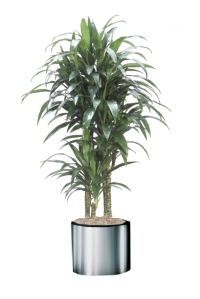 Yesterday I bought some pretty flowers for our front porch and a few herbs for the back yard to plant next to the three tomato plants a friend gave to me. I enjoyed the added beauty so much that I went on a little shopping trip today for an indoor plant to help cleanse the air in our home. I was drawn to a two foot tall palm that was wearing a tag that said “air purifier.”It was a decent size and only ten bucks (and I was in a hurry as I was shopping with a squirmy toddler) so I purchased it.
Yesterday I bought some pretty flowers for our front porch and a few herbs for the back yard to plant next to the three tomato plants a friend gave to me. I enjoyed the added beauty so much that I went on a little shopping trip today for an indoor plant to help cleanse the air in our home. I was drawn to a two foot tall palm that was wearing a tag that said “air purifier.”It was a decent size and only ten bucks (and I was in a hurry as I was shopping with a squirmy toddler) so I purchased it.I LOVE our home. It is incredibly energy efficient. The doors and windows are sealed well, the entire house has walls of double paned windows in every room. We can open the shades to warm up or close the drapes to keep heat in. Our utility bills are quite low. Yet this energy efficiency presents a potential problem- indoor air quality.
In the past I have had philodendron, pothos, and peace lilies primarily to keep the indoor air clean but now I have a toddler who puts anything and everything into his mouth. In case you did not know, peace lilies are poisonous. (The other two did not make the top ten list, thought they are on the top fifteen) And I just read that English Ivy are poisonous to pets. I recommend keeping the plants out of the reach of children or pets anyway but for my clear conscience, I needed to state the obvious.
According to NASA these are the top ten indoor plants for removing formaldehyde, benzene, TCE, and carbon monoxide from the air.
- Bamboo Palm – Chamaedorea Seifritzii
- Chinese Evergreen – Aglaonema Modestum
- English Ivy- Hedera Helix
- Gerbera Daisy- Gerbera Jamesonii
- Janet Craig – Dracaena “Janet Craig”
- Marginata – Dracaena Marginata
- Mass cane/Corn Plant – Dracaena Massangeana
- Mother-in-Law’s Tongue Sansevieria Laurentii
- Pot Mum – Chrysantheium morifolium
- Peace Lily – Spathiphyllum
- Warneckii – Dracaena “Warneckii”
To learn more about the nasty chemicals: trichloroethylene, benzene, and formaldehyde from the NASA site click here
NASA also noted that some plants are better than others in treating certain chemicals.
Here is a chart to make it a little easier to look at which plants help remove which pollutants:
Pollutant Source Plants that Remove Pollutant
| Benzene | Inks, oils, paints, plastics,rubber, dyes, detergents,gasoline, pharmaceutical,tobacco smoke, synthetic fibers | English Ivy, Dracaena marginata, Janet Craig, Warneckei, Chrysanthemum, Gerbera Daisy, Peace lily |
| Formaldehyde | Foam insulation, plywood, pressed-wood products, grocery bags, waxed paper, fire retardants, adhesive binders in floor coverings, cigarette smoke, natural gas | Azalea, Philodendron, Spider plant, Golden Pothos, Bamboo palm, Corn plant, Chrysanthemum, Mother-in-law’s tongue |
| Trichloroethylene | Primarily used in the metal degreasing and dry cleaning industries; also in printing inks, paints, lacquers, varnishes, adhesives | Gerbera Daisy, Chrysanthemum, Peace lily, Warneckei, Dracaena marginata |
For an average home of under 2,000 square feet, the NASA study recommends using at least fifteen samples of a good variety of these common houseplants to help improve air quality. ( 15…that’s a lot! But anything helps.) They also recommend that the plants be grown in six inch containers or larger. I also read one 6″ plant per every 100 sq ft.
*Information obtained from The Foliage For Clean Air Council and National Academy of Sciences. Again, the link.
I love the flowers, herbs, and vegetable gardens outside in the Spring. But after reading all of this and writing it out for the blog, I am inspired to go out and purchase more plants to beautify the inside of my house and keep the air quality as high as possible for those I love, myself included. I noticed two gerbera daisies blooming outside. I may just pot one and bring it inside now that I know it has indoor healing benefits too.
